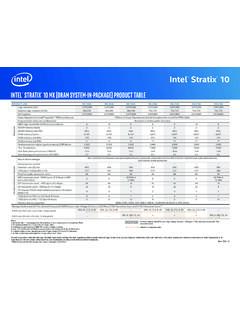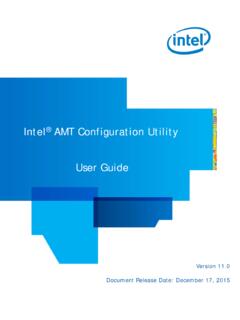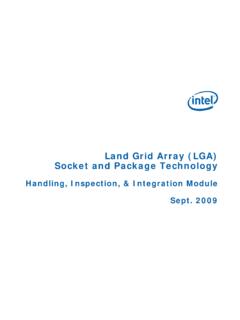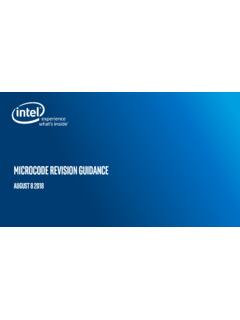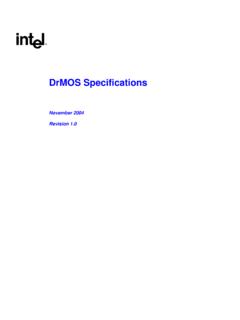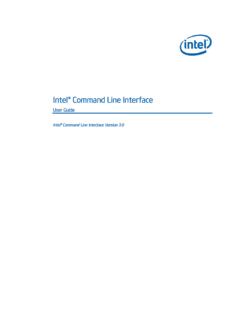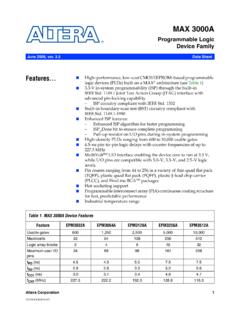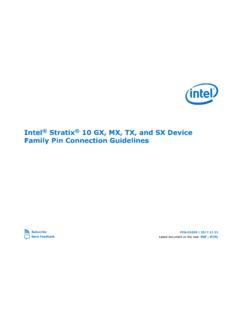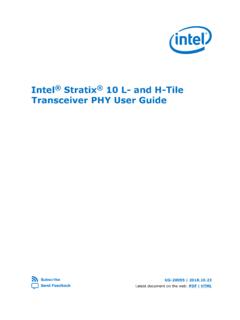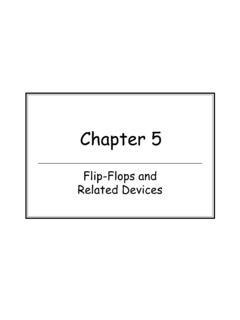Transcription of MAX V Device Handbook - intel.com
1 101 Innovation DriveSan Jose, CA MAX V Device HandbookSubscribeMAX V Device Handbook MAX V Device Handbook June 2017 Altera Corporation 2017 Altera Corporation. All rights reserved. ALTERA, ARRIA, CYCLONE, HARDCOPY, MAX, MEGACORE, NIOS, QUARTUS and STRATIX are Reg. Tm. Off. and/or trademarks of Altera Corporation in the and other countries. All other trademarks and service marks are the property of their respectiveholders as described at Altera warrants performance of its semiconductor products to current specifications in accordancewith Altera s standard warranty, but reserves the right to make changes to any products and services at any time without notice.
2 Altera assumes no responsibility orliability arising out of the application or use of any information, product, or service described herein except as expressly agreed to in writing by Altera. Alteracustomers are advised to obtain the latest version of Device specifications before relying on any published information and before placing orders for products 2017 Altera CorporationMAX V Device HandbookContentsSection I. MAX V Device CoreChapter 1. MAX V Device Family OverviewFeature Summary .. 1 1 Integrated Software Platform .. 1 3 Device Pin-Outs .. 1 3 Ordering Information .. 1 4 Document Revision History .. 1 4 chapter 2.
3 MAX V ArchitectureFunctional Description .. 2 1 Logic Array Blocks .. 2 4 LAB Interconnects .. 2 6 LAB Control Signals .. 2 6 Logic Elements .. 2 8 LUT Chain and Register Chain .. 2 9addnsub Signal .. 2 9LE Operating Modes .. 2 9 Normal Mode .. 2 10 Dynamic Arithmetic Mode .. 2 10 Carry-Select Chain .. 2 11 Clear and Preset Logic Control .. 2 13LE RAM .. 2 13 MultiTrack Interconnect .. 2 14 Global Signals .. 2 19 User Flash Memory Block .. 2 21 UFM storage .. 2 22 Internal Oscillator .. 2 22 Program, Erase, and Busy Signals .. 2 23 Auto-Increment Addressing .. 2 23 Serial Interface .. 2 23 UFM Block to Logic Array Interface .. 2 24 Core Voltage.
4 2 25I/O Structure .. 2 26 Fast I/O Connection .. 2 27I/O Blocks .. 2 28I/O Standards and Banks .. 2 29 PCI Compliance .. 2 32 LVDS and RSDS Channels .. 2 32 Schmitt Trigger .. 2 32 Output Enable Signals .. 2 33 Programmable Drive Strength .. 2 33 Slew-Rate Control .. 2 34 Open-Drain Output .. 2 34 Programmable Ground Pins .. 2 34 Bus-Hold .. 2 34 Programmable Pull-Up Resistor .. 2 35 Programmable Input Delay .. 2 35ivContentsMAX V Device HandbookJune 2017 Altera CorporationMultiVolt I/O Interface .. 2 35 Document Revision History .. 2 36 chapter 3. DC and Switching Characteristics for MAX V DevicesOperating Conditions .. 3 1 Absolute Maximum Ratings.
5 3 1 Recommended Operating Conditions .. 3 2 Programming/Erasure Specifications .. 3 3DC Electrical Characteristics .. 3 3 Output Drive Characteristics .. 3 5I/O Standard Specifications .. 3 5 Bus Hold Specifications .. 3 8 Power-Up Timing .. 3 9 Power Consumption .. 3 10 Timing Model and Specifications .. 3 10 Preliminary and Final Timing .. 3 11 Performance .. 3 11 Internal Timing Parameters .. 3 12 External Timing Parameters .. 3 19 External Timing I/O Delay Adders .. 3 23 Maximum Input and Output Clock Rates .. 3 26 LVDS and RSDS Output Timing Specifications .. 3 27 JTAG Timing Specifications .. 3 29 Document Revision History .. 3 30 Section II.
6 System Integration in MAX V DevicesChapter 4. Hot Socketing and Power-On Reset in MAX V DevicesMAX V Hot-Socketing Specifications .. 4 1 devices Can Be Driven Before Power Up .. 4 2I/O Pins Remain Tri-Stated During Power Up .. 4 2 Signal Pins Do Not Drive the VCCIO or VCCINT Power Supplies .. 4 2AC and DC Specifications .. 4 2 Hot-Socketing Feature Implementation in MAX V devices .. 4 3 Power-On Reset Circuitry .. 4 5 Power-Up Characteristics .. 4 5 Document Revision History .. 4 6 chapter 5. Using MAX V devices in Multi-Voltage SystemsI/O Standards .. 5 1 MultiVolt I/O Operation .. 5 Device Compatibility .. 5 3 Recommended Operating Conditions for Compatibility.
7 5 7 Power-Up Sequencing .. 5 8 Document Revision History .. 5 8 chapter 6. JTAG and In-System Programmability in MAX V DevicesIEEE Std. Boundary-Scan Support .. 6 1 JTAG Block .. 6 4 Parallel Flash Loader .. 6 4In-System Programmability .. 6 5 IEEE 1532 Support .. 6 6 Jam Standard Test and Programming Language .. 6 6 ContentsvJune 2017 Altera CorporationMAX V Device HandbookProgramming Sequence .. 6 6 User Flash Memory Programming .. 6 7In-System Programming Clamp .. 6 7 Real-Time ISP .. 6 8 Design Security .. 6 8 Programming with External Hardware .. 6 8 Document Revision History .. 6 9 chapter 7. User Flash Memory in MAX V DevicesUFM Array Description.
8 7 1 Memory Organization Map .. 7 2 Using and Accessing UFM storage .. 7 2 UFM Functional Description .. 7 3 UFM Address Register .. 7 5 UFM Data Register .. 7 6 UFM Program/Erase Control Block .. 7 6 Oscillator .. 7 7 Instantiating the Oscillator without the UFM .. 7 7 UFM Operating Modes .. 7 8 Read/Stream Read .. 7 9 Program .. 7 10 Erase .. 7 11 Programming and Reading the UFM with JTAG .. 7 12 Jam Files .. 7 12 Jam Players .. 7 12 Software Support for UFM Block .. 7 13 Inter-Integrated Circuit .. 7 13I2C Protocol .. 7 13 Device Addressing .. 7 15 Byte Write Operation .. 7 16 Page Write Operation .. 7 17 Acknowledge Polling .. 7 17 Write Protection.
9 7 17 Erase Operation .. 7 17 Read Operation .. 7 20 ALTUFM_I2C Interface Timing Specification .. 7 22 Instantiating the I2C Interface Using the Quartus II ALTUFM_I2C Megafunction .. 7 23 Serial Peripheral Interface .. 7 23 Opcodes .. 7 25 ALTUFM SPI Timing Specification .. 7 35 Instantiating SPI Using Quartus II ALTUFM_SPI Megafunction .. 7 35 Parallel Interface .. 7 36 ALTUFM Parallel Interface Timing Specification .. 7 37 Instantiating Parallel Interface Using Quartus II ALTUFM_PARALLEL Megafunction .. 7 37 None (Altera Serial Interface) .. 7 38 Instantiating None Using Quartus II ALTUFM_NONE Megafunction .. 7 38 Creating Memory Content File.
10 7 39 Memory Initialization for the ALTUFM_PARALLEL Megafunction .. 7 39 Memory Initialization for the ALTUFM_SPI Megafunction .. 7 39 Memory Initialization for the ALTUFM_I2C Megafunction .. 7 40 Simulation Parameters .. 7 43 Document Revision History .. 7 43viContentsMAX V Device HandbookJune 2017 Altera CorporationChapter 8. JTAG Boundary-Scan Testing in MAX V DevicesIEEE Std. BST Architecture .. 8 2 IEEE Std. Boundary-Scan Register .. 8 3 Boundary-Scan Cells of a MAX V Device I/O Pin .. 8 4 JTAG Pins and Power Pins .. 8 5 IEEE Std. BST Operation Control .. 8 6 SAMPLE/PRELOAD Instruction Mode .. 8 8 EXTEST Instruction Mode .. 8 10 BYPASS Instruction Mode.
